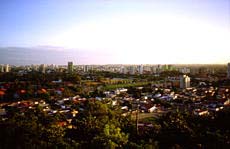|
Advertising by Google
Natal, Rio Grande do Norte
Area: 170 km²
Population: 712.317 inhab. (est. 2000).
See map of Rio Grande do Norte.
Natal means Christmas in Portuguese. The city received this name because it was founded on Dec. 25th of 1599.
Known as Sun of the City, Natal is rapidly becoming of of the main tourist destinations in Brazil, both for Brazilians and for foreigner travellers; it´s easy to understand why: Natal has beautiful beaches, blue and warm sea, dunes and sun the whole year.
The historical district of the city has preserved buildings that date from the time of its colonization; the Fortress of Wise Kings, first building of the city, is today open to visitation.
During the 17th century, Natal was invaded and occupied by the Dutch. More recently, during the Second World War, it served as a base for American troops and was also known as the "Trampoline of Victory". That aspect is also reflected in the city of Natal.
 Before going out in search of the sun on the beaches, dunes and coconut groves that stretch the length of the coastline of Rio Grande do Norte, it is well worth visiting a few monuments in order to get a better understanding of this region that was so fiercely fought over by the Europeans.
Before going out in search of the sun on the beaches, dunes and coconut groves that stretch the length of the coastline of Rio Grande do Norte, it is well worth visiting a few monuments in order to get a better understanding of this region that was so fiercely fought over by the Europeans.
The point of departure could be the Fortaleza dos Reis Magos (Three Kings' Fortress), where the city had its origins. Surrounded by a star-shaped wall, it was built by the Portuguese between 1598 and 1628 to defend Natal from the Dutch invasion.
Another construction dating from that period is the ancient Metropolitan Cathedral that was inaugurated in 1694 and recently restored. The Theater Alberto Maranhão built in 1898 and registered by the state Historical Heritage, is an example of architecture from the colonial era, and so is the church of St. Antonio, built in the eighteenth century.
Other important places to learn more about the History of Natal, Rio Grande do Norte and Brazil are the Museum Camara Cascudo and the Memorial Camara Cascudo. Camara Cascudo was a sociologist born in the State who became one of the greatest authorities in Brazilian popular culture.
 Natal is best known for their beaches. The main urban beaches are Forte, Meio, Artistas and Areia Preta and Ponta Negra; in Ponta Negra, one may glimpse the hill of Careca, an enormous sand dune partially covered with vegetation which became the principal landmark of the city.
Natal is best known for their beaches. The main urban beaches are Forte, Meio, Artistas and Areia Preta and Ponta Negra; in Ponta Negra, one may glimpse the hill of Careca, an enormous sand dune partially covered with vegetation which became the principal landmark of the city.
The beaches of Genipabu and Buzios are situated in the neighbourhood of Natal, and are usually included in the beach tours. Further to the south, foreigners have made the beach of Pipa world famous.
Read more:
Natal. The most complete guide about Natal.
Natal official site. Published by the city government.
Universidade Federal do Rio Grande do Norte. The Federal University of Rio Grande do Norte, campus of Natal.
Back to Top
|
|